
What Are Shape Memory Alloys (SMAs)?
Shape Memory Alloys (SMAs) are a unique class of materials that can return to a predetermined shape when subjected to a specific thermal process. This remarkable property arises from a phase transformation between two solid phases: martensite and austenite.
They exhibit unique behavior through martensitic and austenitic transformations. At low temperatures, SMAs are in the easily deformable martensitic phase; when deformed, they return to their original shape upon heating as they shift to the stronger, less deformable austenitic phase. If the SMA is deformed while in the austenitic phase and then unloaded, it exhibits superelastic behavior by returning to its original shape.

Key properties of Shape Memory Alloys include:
- Shape Memory Effect (SME): SMAs can “remember” their original shape and return to it upon heating after being deformed at a lower temperature. This is due to the reversible phase transformation between the low-temperature martensitic phase and the high-temperature austenitic phase.
- Superelasticity: SMAs can undergo large deformations and recover their original shape upon unloading, without the need for heating. This occurs when the material is in the austenitic phase at a temperature above its transformation point.
- High Damping Capacity: SMAs can absorb and dissipate a significant amount of energy, making them useful for vibration damping and shock absorption.
- Corrosion Resistance: Many SMAs, particularly Nitinol, exhibit excellent resistance to corrosion, which is advantageous in biomedical and marine applications.
- Biocompatibility: Certain SMAs, like Nitinol, are biocompatible and are therefore suitable for medical implants and devices.
Related reading: Nitinol – Amazing Shape Memory Alloy
Common Types of Shape Memory Alloys
1. Nickel-Titanium Alloys (Nitinol)
Composition: Typically around 55% Nickel and 45% Titanium.
Nitinol is the most widely used SMA, particularly in the medical field for stents, guidewires, and orthodontic archwires. It is also used in actuators, sensors, and eyeglass frames due to its superelasticity and corrosion resistance.
2. Copper-Based Alloys
Common Types: Cu-Zn-Al and Cu-Al-Ni alloys.
These alloys are used in less demanding applications than Nitinol due to their lower cost but similar shape memory properties. They are often used in temperature control systems, actuators, and connectors.
3. Iron-Based Alloys
Common Types: Fe-Mn-Si alloys.
Iron-based SMAs are typically used in civil engineering applications for seismic dampers and reinforced concrete structures due to their high damping capacity and ability to withstand large stresses.
Advanced Refractory Metals (ARM) is a leading supplier of refractory metals across the world. We offer high-quality refractory metals & alloys like titanium and titanium alloys at a very competitive price. Send us an inquiry if you are interested.
How Are Shape Memory Alloys Used?
1. Medical Devices
– Stents: Nitinol stents expand at body temperature to open up blood vessels, providing support in angioplasty procedures.
– Orthodontic Wires: Nitinol wires are used in braces to apply consistent pressure on teeth, gradually moving them into the desired position.
– Surgical Tools: SMAs are used in minimally invasive surgery for tools that can change shape during the procedure.
2. Aerospace and Defense
– Actuators and Sensors: SMAs are used in aircraft for adaptive structures, such as variable geometry wings and noise reduction systems. They are also employed in spacecraft for deployment mechanisms.
– Missile Components: SMAs are used in missile systems for components that require precise movement and activation under changing thermal conditions.
3. Robotics and Automation
– Actuators: SMAs are used as actuators in robots, where their ability to contract and expand in response to temperature changes can be harnessed for movement.
– Adaptive Systems: SMAs are used in adaptive robotics for components that can change shape and stiffness, enabling robots to interact more effectively with their environments.
4. Consumer Electronics
– Eyeglass Frames: Nitinol frames can return to their original shape after being bent, providing durability and comfort.
– Flexible Electronics: SMAs are used in flexible electronic devices that can change shape or position based on temperature or environmental conditions.
5. Civil Engineering
– Seismic Dampers: Iron-based SMAs are used in buildings and bridges to absorb and dissipate energy during earthquakes, reducing structural damage.
– Reinforced Concrete: SMAs are incorporated into concrete structures to provide additional strength and flexibility, enhancing their ability to withstand dynamic loads.
6. Automotive Industry
– Temperature Control Valves: SMAs are used in automotive engines and HVAC systems for temperature-sensitive control valves that adjust flow rates based on operating conditions.
– Adaptive Structures: SMAs are used in automotive components that need to change shape or stiffness in response to different driving conditions, such as adaptive suspensions.
Conclusion
Shape memory alloys come with diverse applications ranging from medical devices to aerospace, robotics, and civil engineering due to their shape memory effect, superelasticity, and high damping capacity. As research continues, the development of new SMAs and their integration into emerging technologies are expected to expand their applications even further.

